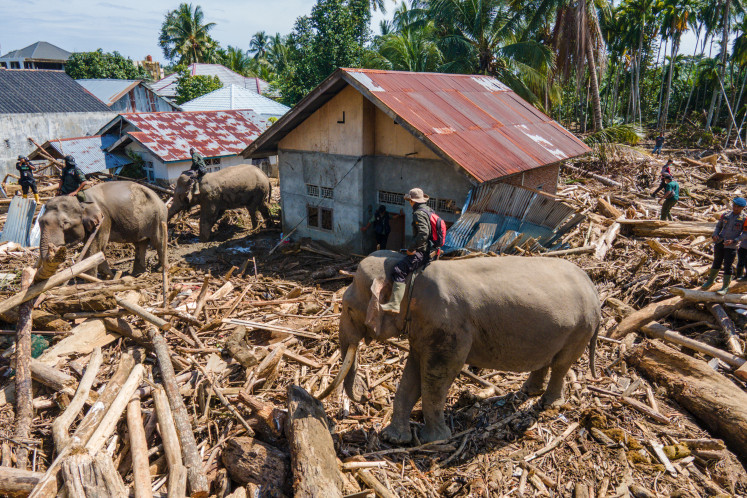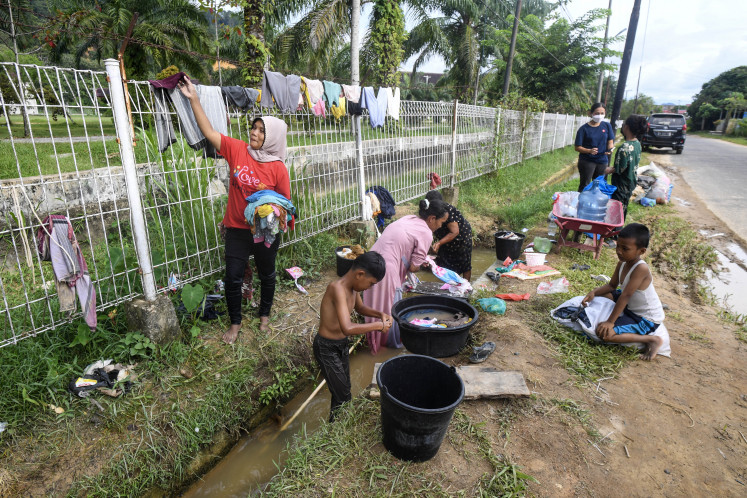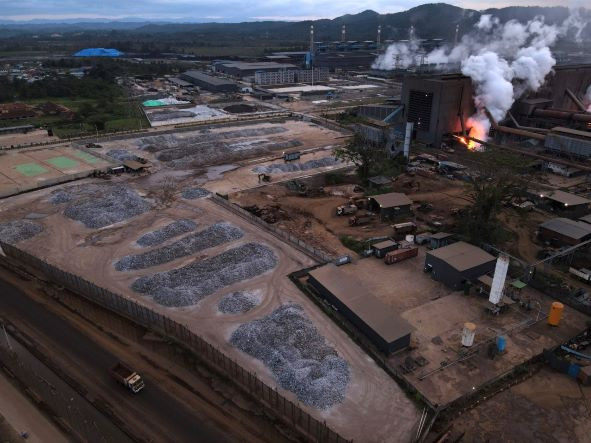Popular Reads
Top Results
Can't find what you're looking for?
View all search resultsPopular Reads
Top Results
Can't find what you're looking for?
View all search results“An eye for an eye makes us all blind.”
Prodita SabariniPhotographer Toshi Kazama’s photographs of execution chambers, death row inmates and victims’ families show the reality of the death penalty that most of us don’t see
Change text size
Gift Premium Articles
to Anyone
Prodita Sabarini
Photographer Toshi Kazama’s photographs of execution chambers, death row inmates and victims’ families show the reality of the death penalty that most of us don’t see. He also asks a very important question to people who support the death penalty.
Straps dangle on a wooden chair. There’s a faint dark burn mark on the middle of the seat. It’s a chair used to kill death row inmates by electrocution in Alabama, US. The tailbone of the electrocuted inmate sometimes burns the seat leaving the mark, said Toshi Kazama, a New York-based photographer and death penalty abolitionist.
Kazama was in Jakarta recently, exhibiting his photographs of execution chambers, portraits of children on death row and victims’ families, mostly from the US and some countries in Asia. His photos recently lined a corridor in Plaza Indonesia as part of the Festival “A Week of Celebrating Life” organized by the Coalition for the Abolition of Death Penalty in ASEAN.
Kazama’s photographs show the reality of the death penalty. But he also has a question to ask the Indonesian public.
In the 18 months of President Joko “Jokowi” Widodo’s administration, 18 death row inmates, mostly convicted drug traffickers, have been executed by firing squad.
Jokowi considers this a solution to the illegal drug trade and he has the support of a majority of Indonesians. According to a 2015 Indo-Barometer survey, 84 percent of the Indonesian public supports the death penalty for drug traffickers.
“I want to ask each and every one of you. Do you have the guts to kill this drug trafficker or murderer, with your own hands? Can you pull the trigger?” he asked.
“I don’t,” he said.
Kazama’s questions come at a time when Indonesia and its neighbors in Southeast Asia are witnessing a rise in state-ordered killings. The festival in Jakarta comes a little over a month after the third wave of executions in Indonesia.
“You have to understand, it’s you who is doing the killing, not the executioner. He’s just doing a job for you,” he said.

Silent witness: Yellow Mama, Alabama’s electric chair. (Courtesy of Toshi Kazama. Copyrighted. All rights reserved.)
Recently, Philippine President Rodrigo Duterte, whose tough stance on fighting drug crime has encouraged the extrajudicial killing of more than 2,000 people, reportedly gave a green light for Jokowi to execute Philippine national Mary Jane Veloso.
Sitting in the Mandarin Oriental on his last day in Jakarta before flying off to New York via Tokyo, Kazama talked about what had pushed him to work on the theme of the death penalty.
The chair — called Yellow Mama by the people in Alabama — was the first picture that he took of an execution chamber, he said.
Twenty years ago, Kazama was a successful commercial photographer who photographed famous musicians for CD covers and had his work appear in magazines such as Italian Vogue. “I was a pretty successful photographer and I only thought about myself,” he said.
In 1996, he decided to take pictures of juvenile death row inmates to explore a different path in his career. “To be honest with you, I thought I would do a couple of death row inmates and publish them in Time or Newsweek,” he said. “I thought it would help my career. I had that idea in the corner of my mind too,” he said.
Kazama now in his late 50s, has always found the idea of killing someone as a form of punishment uncomfortable.
Born in Japan, Kazama moved to the US at 15. He remembers being bewildered watching Hollywood movies in the theater and people cheered when the good guy killed the bad guy.
The sinking feeling never left him as he grew up. “I got married. I have children. And this question that I had got bigger and bigger,” he said. The death penalty then became a natural theme for him to explore outside of his commercial work.
It was not easy to start this endeavor. He found a list of juveniles on death-row from university research. He learned that a 16-year-old boy name Michael Barnes in Alabama was on death row.
He called the warden of the Alabama prison to ask permission and was immediately rejected and told never to call again.
“I was a little amused by this so even though he told me to never call him back, I called him back. He got angrier obviously,” he said. But the warden told him if the Alabama Department of Corrections gave their permission, he would have to follow suit.
With the help of lawyers, Kazama asked permission from the Department of Corrections. After eight months, Kazama received permission.
The warden turned out to be a genuinely nice guy, Kazama said.
Meeting Barnes, his first portrait subject with an IQ of around 70, changed Kazama’s life.
“I had no idea who I was going to meet. I was so stunned. He wasn’t a monster. He was a regular 16-year-old boy who I could easily find in my son’s classroom,” he said.
“When that thought came, I started to think what if I was born like him? I would be on death-row and I would be photographed by this weird Asian photographer,” he said.
He decided right then to treat Barnes as he would like to be treated by others. Kazama shook his hand and embraced Barnes. The first sentence that Barnes uttered was: “I’m a bitch.” The second was “I’m afraid of one hour.”
Kazama later found out that inmates were given one hour out of their cells where they exercised or took a shower. Kazama also discovered that being a “bitch” in prison slang meant that Barnes had been raped by the other inmates.
After taking a picture of Barnes, Kazama said he could not go on doing commercial photography. “The day after I photographed [Barnes] I had to fly to New York to shoot CD covers and I usually enjoy shooting these musicians so much but the depth of the thing is completely different. I felt I could not go on,” he said.
“I never thought I would have no interest in commercial photography because I enjoy making images of reality. I photograph images that are alive but there’s always a shadow of death behind them because they [the death row inmates] are going to be executed,” he said. “I could no longer wash my hands and say goodbye.”
Barnes’ sentence was commuted to life-in-prison after the US Supreme Court ruled in 2005 against the death penalty for child offenders. The Supreme Court’s decision was based on the case of another child on death row, Christopher Simmons. Kazama also photographed Simmons.
Kazama said there were other children on death row who he photographed and who were executed before the 2005 Supreme Court ruling.
Kazama believes the issue of the death penalty encapsulates all societal issues. “It has [the problem of] poverty. It has [the problem of] education. Each case shows all the ill parts of society,” he said.
Around the world, the poor and uneducated disproportionately face the death penalty.
“And as a society, the only solution we come up with is to kill another human being in the name of justice, or in the name of the victims,” he said.
Kazama, who 13 years ago survived an attack that almost killed him, says revenge does not help victims to heal. He has permanent damage to his hearing and balance, but he does not want to be burdened by anger and hatred. He said a lot of victims’ families feel the same way.
Kazama said the death penalty seemed like an easy way out. “But it doesn’t make society a better place. We have killed many human beings in our history. We live over the corpse of dead bodies. It’s a cycle of violence,” he said.
“An eye for an eye makes us all blind.”










